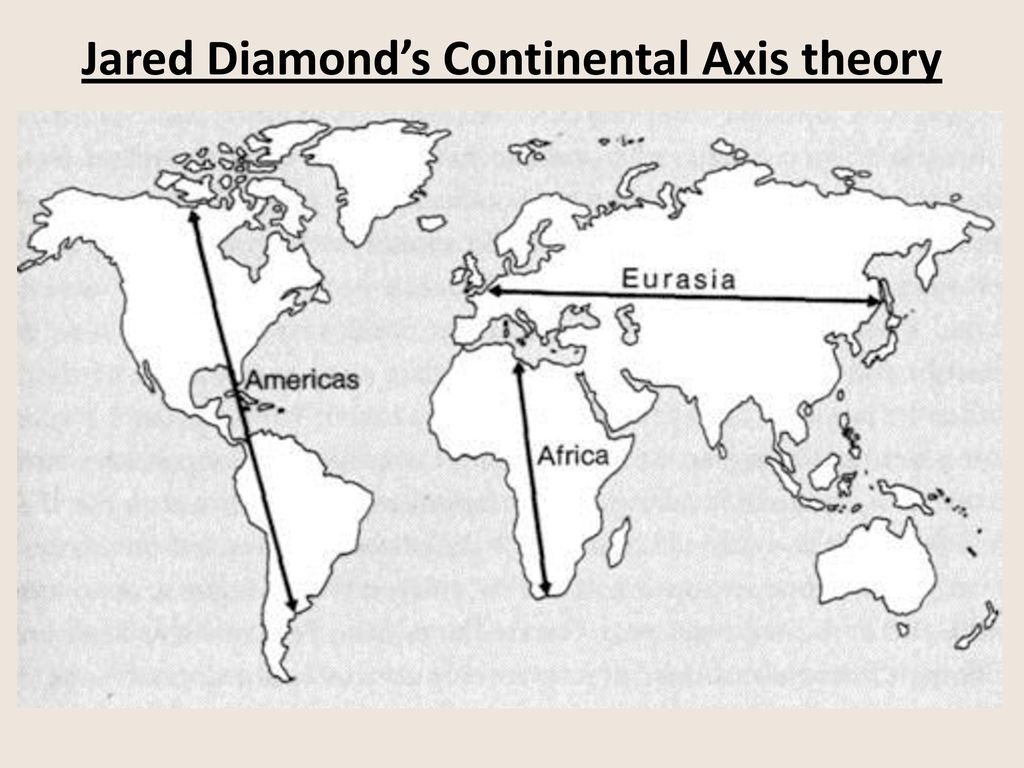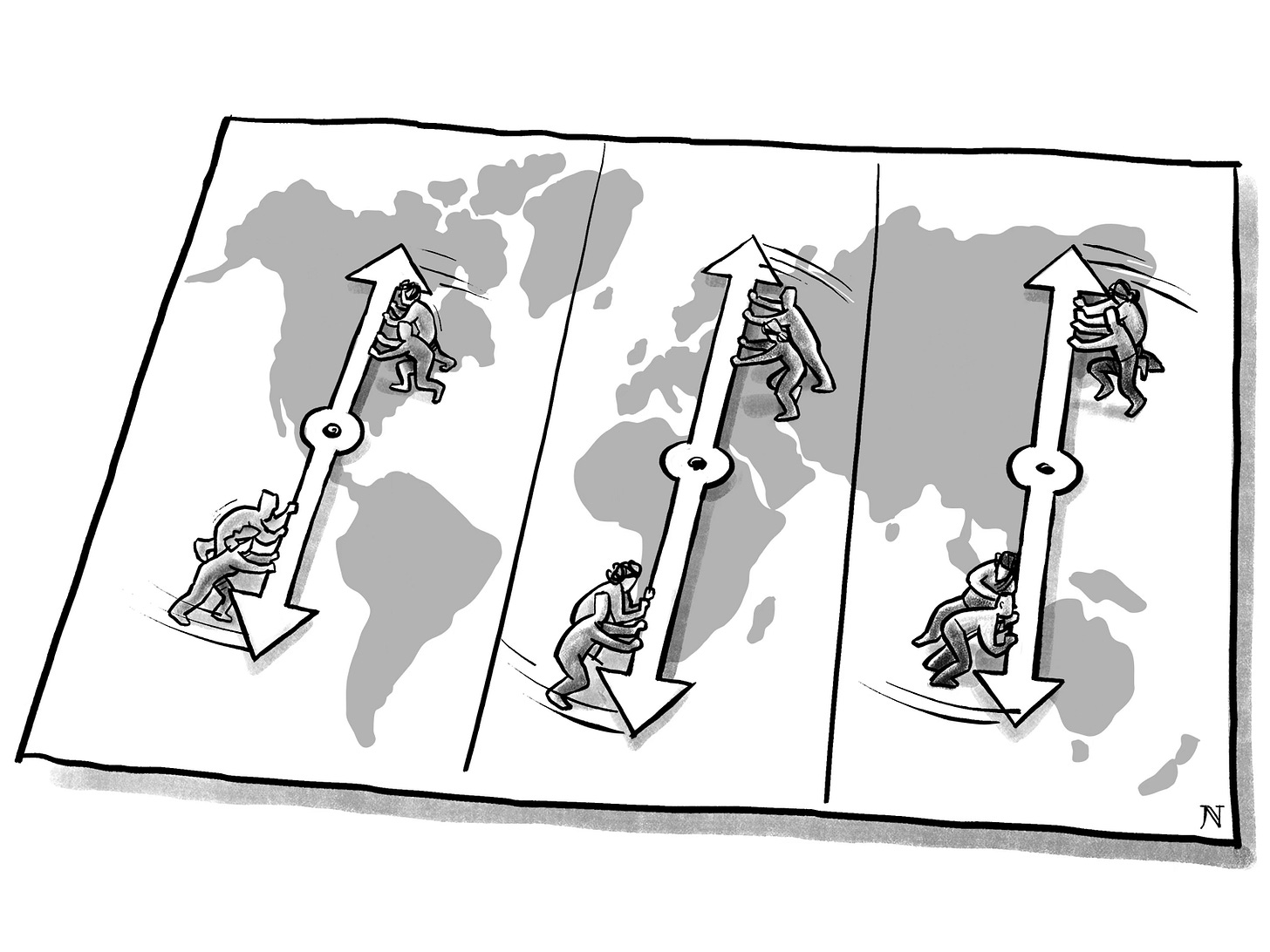Geo-strategic optimism about climate change
Compared to the East, the Western Hemisphere is geographically advantaged
Climate change presents a great number of challenging dynamics for all of humanity, but unevenly so.
First off, it’s going to be far more challenging for anyone living in lower latitudes than in higher latitudes. In the lower latitudes, or what I call Middle Earth (stretching 30 degrees north and south of the equator and home to well over half of humanity), people are going to experience temperature ranges and precipitation rates historically associated with the Saharan Desert — a very hard place to live in, primarily because it’s extremely hard to grow food there.
Each year, places like Miami, located at 25 degrees north, are going to see more and more calendar days lost to extreme climate. If you have money, you’ll be fine — and largely indoors (and hopefully above high tide). But if you don’t have that kind of money and thus are forced to handle these days with minimal technical assistance, then things will become unbearable and even dangerous — especially for those forced to work outdoors during the day.
Needless to say, it will get far harder to grow food in lower latitudes, mostly because of drought but also because, when precipitation does flow, it’ll be more erratic and overwhelming — to include flooding.
More flooding AND drought … I know, it boggles the mind.
Second, climate change is going to stress the Eastern Hemisphere far more than the Western Hemisphere. We in the West are less geographically exposed. Far more of the Western Hemisphere’s landmass is located, as a percentage of the total, outside of that Middle Earth band than within it. In effect, the Western Hemisphere is very “tall” (stretching to almost both poles) and quite “thin” in the middle (epitomized by Central America).
Compared to the Western Hemisphere, the Eastern half of our planet has far more of its population living within Middle Earth’s band, particularly to the northern side, which historically was the climatic sweet spot (25-30 degrees north) for the rise of ancient civilizations like Egypt, Babylon, India, and China. To this day, the most densely populated latitudes are 25 and 26 degrees north, whereas roughly half of humanity lives in the 30-31 degree north band.
You just look at this map and you see what I mean: the West is taller than it is wide, while the East is wider than it is tall.
As I point out in America’s New Map, this is a complete reversal of the situation described by Jared Diamond in his book, Guns, Germs, and Steel
It was the great Eurasian landmass’s width, relative to its height, that created that vast swath of “sweet spot” climate stretching from Ireland to Japan. The homogeneity of that band allowed for innovations to spread rapidly across it, in turn allowing civilizations there to develop more rapidly, ultimately explaining how and why these peoples later came to dominate and wipe out less advanced civilizations in taller-than-wider continents like the Americas and Africa during the Age of Discovery (15th-17th centuries).
In my book, I call this previous geostrategic reality as the time “When Wide Beat Tall.”
So, if the pre-Industrial Era’s world climate favored the Wide over the Tall, then its post-Industrial Era’s changed climate now favors the Tall over the Wide.
Crazy, right?
To me, these are the buried headlines of the 21st century with its changing climate:
Higher, “emptier” latitudes beat lower, more “crowded” latitudes
The “taller” Western Hemisphere beats the mostly “wider” Eastern Hemisphere.
Put those two together and guess where it makes the most sense to live this century: that’s right, North America and arguably Canada in particular.
As I argued recently in Politico, this logic alone accounts for Trump’s instinctive desire to integrate Canada with the United States.
Not a crazy idea whatsoever … if you look at the world system in whole this century: where its pain points lie and what will fix them.
As my book argues, two great disparities are thus unevenly spread by latitude:
Climate change
Demographics.
Those two realities speak to the logic of North-South integration and not East-West integration.
Why?
Pain and stress and resource-deficiencies (most importantly, lowered food production) in the lower latitudes will motivate human migration to the higher latitudes, where populations are shrinking already. By contrast, it makes little-to-no sense to migrate longitudinally as a rule, because you’re just running into more of the same (e.g., old people bumping into more old people [or conversely young-on-young], climate migrants escaping one frying pan to jump into another fire).
The world system cannot sustain these two great and simultaneous disparities across this century. Something will have to give.
Worst case scenario: the North walls itself off from the South and tells them to go fish. This is the original Trump 1.0 instinct that survives in Trump 2.0.
But more logically, you want to balance out this latitudinal risk, and you do that by encouraging the aggregation of states along north-south lines (Greenland Canada, Panama — oh my!). This is the new Trump 2.0 instinct that puzzles people the world over, to include much of the MAGA faithful.
Thus, it makes sense for the Americas to come together in the Western Hemisphere, while, in the Eastern Hemisphere, it’ll make sense for Europe to integrate southward in one vertical “slice” that encompasses the Middle East and Africa, and for Asia as a whole to integrate latitudinally in a third vertical “slice” (or how I see the old Russian Empire finally disappearing).
For those of you who track back to The Pentagon’s New Map, you’ll note that my description of the more-stressed regions remains the same (lower latitudes), but that my logic is now one of divvying up the North-South integration task (described in PNM as the “Core shrinking the Gap”) among the world’s three clear manufacturing/consumer hubs:
North America
Europe
East Asia.
As posts go, a bit of a review/primer but one I felt needed re-introducing since my subscription base has grown so rapidly in the past couple of months.
I know I spend a lot of time here pointing out bad signposts of the future, so it’s key, every once in a while, to remind people why they shouldn’t freak out: there are logical paths forward, and America, as usual, is blessed.
Keep reading with a 7-day free trial
Subscribe to Thomas P.M. Barnett’s Global Throughlines to keep reading this post and get 7 days of free access to the full post archives.











